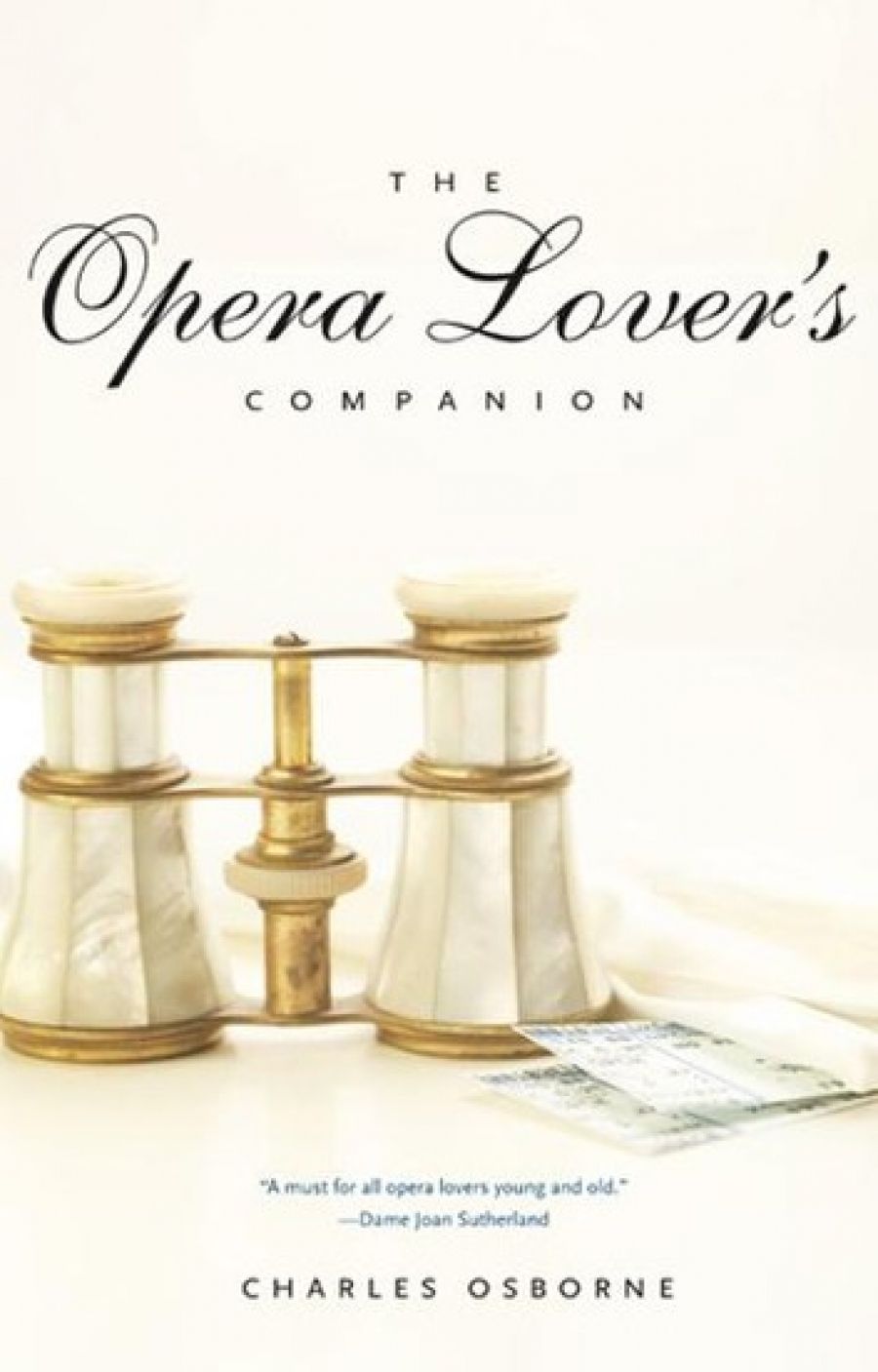
- Free Article: No
- Contents Category: Opera
- Review Article: Yes
- Online Only: No
- Custom Highlight Text:
Charles Osborne, who was born in Brisbane in 1927 and moved to London in 1953, is a prolific writer, broadcaster and opera critic. His latest offering, The Opera Lover’s Companion, sets out to guide its reader through 175 of the world’s most popular operas. Osborne correctly states that ‘the staples of the operatic diet today are the major works of five great composers – Mozart, Verdi, Wagner, Puccini, and Strauss’ – and certain works by other luminaries. The operas of sixty-seven composers are included, but that core quintet gives us almost a third of the operas in this volume. Interestingly, in opera’s four hundred-year history, the vast majority of the most frequently performed works fall within the period between Mozart’s first featured opera, Mitridate, rè di Ponto (1770) and Strauss’s last, Capriccio (1942).
As with The New Kobbé’s Opera Book (1997), the list reveals a re-evaluation of many previously neglected operas, in particular some lesser-known works of Handel, Rossini, Donizetti, Massenet, and Strauss, which have enjoyed a renaissance in recent years. Doubtless this also reflects the dearth of modern operas and the scarcity of contemporary composers who know what their audiences want. Any opera company ignoring box office appeal does so at its peril, and a book such as this should be mandatory reading.
- Book 1 Title: The Opera Lover's Companion
- Book 1 Biblio: Yale University Press, $87.95 hb, 639 pp, 0300104405
The composers, in a user-friendly way, are listed alphabetically. Each featured opera is set within the context of its composer’s career. A sensibly sized synopsis follows cast details and relevant background information on the libretto. The date and venue of the first performance is also documented, along with special highlights of the score. Also recognised are other significant works that, although important, have not achieved the level of popularity to make them one of the chosen few. For example, Osborne features only seven of Donizetti’s numerous operas, but mentions at least another eighteen in the course of dealing with that composer’s output.
All the major works are here, but there are some surprises. While recognising the difficulties in deciding what to include in a limited number, I would not have expected Zimmerman’s Die Soldaten or Dallapiccola’s Il prigioniero to take precedence over Boito’s Mefistofele, Korngold’s Die tote Stadt or Mignon by Thomas, which are missing along with their composers. Others not rating a mention include Haydn, Mercadente, Lortzing, and Catalani. Even works like Donizetti’s Roberto Devereux or Puccini’s La rondine are surely better known than Boulevard Solitude, by Henze. And having made a conscious decision to exclude operetta, it is strange to include two by Johann Strauss Junior (Die Fledermaus and Der Zigeunerbaron), wonderful as they are, while there are none by Franz Lehár – not even the ubiquitous The Merry Widow.
Many of the most performed (and most recorded) operas in the repertoire have at least several recordings of distinction. But, with the occasional exception, Osborne limits his ‘recommended recording’ to a single choice. It would take very little extra space to mention at least two versions, in case the reader has an aversion to a particular singer or conductor. This would give the opera novice a choice when selecting a complete recording. It would also give the seasoned listeners a guide when extending their collection with alternate versions – inevitable for many aficionados. Opera lovers rely on recordings to familiarise themselves with a work. For some, the rich legacy of opera on disc may be their only exposure to this art form.
As to Osborne’s actual CD choices, I agree with many, and most of the others are perfectly valid choices – it’s often a question of individual taste. There is the occasional odd recommendation, such as the Serse by Handel (the 1979 Malgoire version on Sony). It is certainly not ‘the only available recording’, and whether it is a ‘first-rate’ performance is debatable. Many prefer the McGegan version (Conifer, 1997). I would not have chosen the Colin Davis version of Humperdinck’s Hänsel und Gretel when there are much more inspired ones, such as the classic Karajan recording with Schwarzkopf and Grummer (EMI, 1953), or more recent ones conducted by Solti (Decca, 1978) and Runnicles (Teldec, 1994). And while I agree that the 1931 recording of Massenet’s Werther (beautifully remastered on Naxos and elsewhere) has never been bettered, there are several respectable modern alternatives, none of which is mentioned.
Occasionally, there is no CD recommendation at all. This is understandable if there is none currently available, but it is peculiar with an opera like Chabrier’s L’Étoile where there has been a much acclaimed version available for years (Gardiner on EMI, 1984). Likewise, there are two acceptable versions of Verdi’s I vespri siciliani (RCA, 1973, and EMI, 1990) and a prominent modern recording of Szymanowski’s King Roger by Simon Rattle (EMI, 1998), but none is acknowledged.
Osborne’s new guide is informative, well written and not aimed at the specialist. But my prime recommendation for most opera lovers must be The New Penguin Opera Guide (2001), which was previously published as The Viking Opera Guide (1993). In a single volume, this covers about two thousand works and includes a generous discography listing three versions of all major works. Another option is the eleventh edition of Kobbé, which includes nearly five hundred operas but contains no recording recommendations. Although there are specific CD guides available, this seems to be a missed opportunity in Osborne’s book, especially when the author is an authoritative expert on the subject and should have an extensive knowledge of what is available on disc. Perhaps subsequent editions can enhance this aspect of a generally excellent book.


Comments powered by CComment